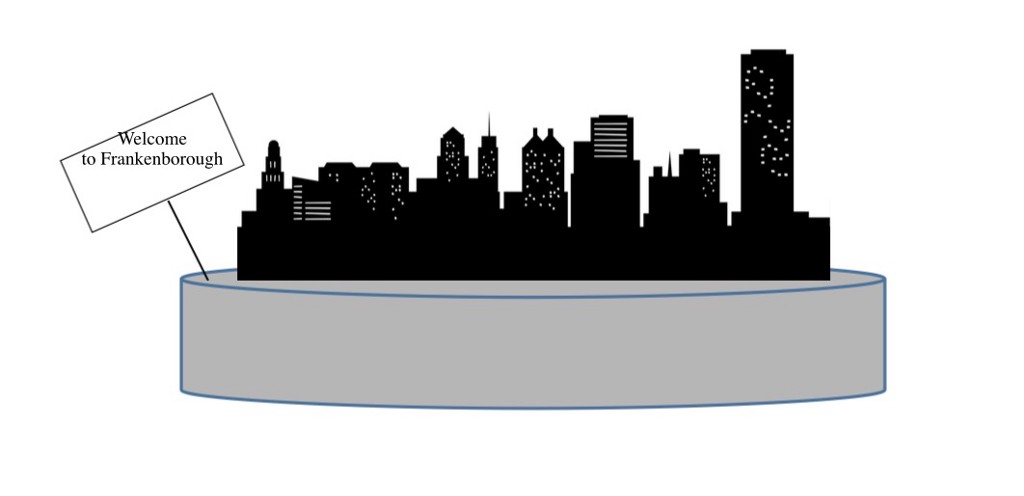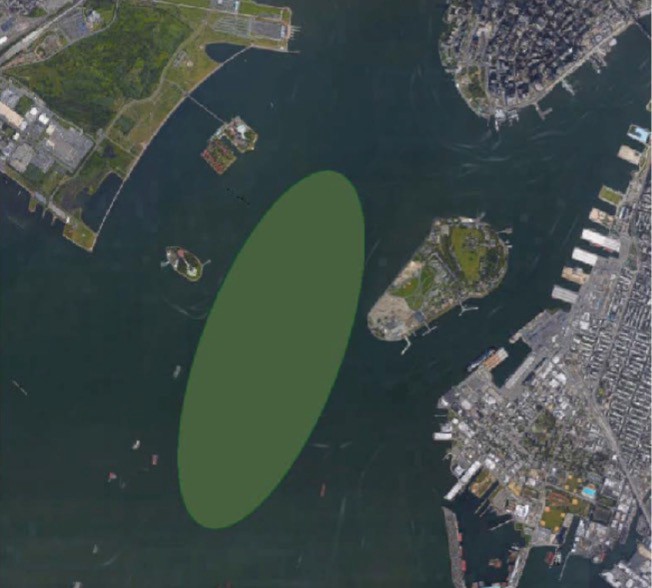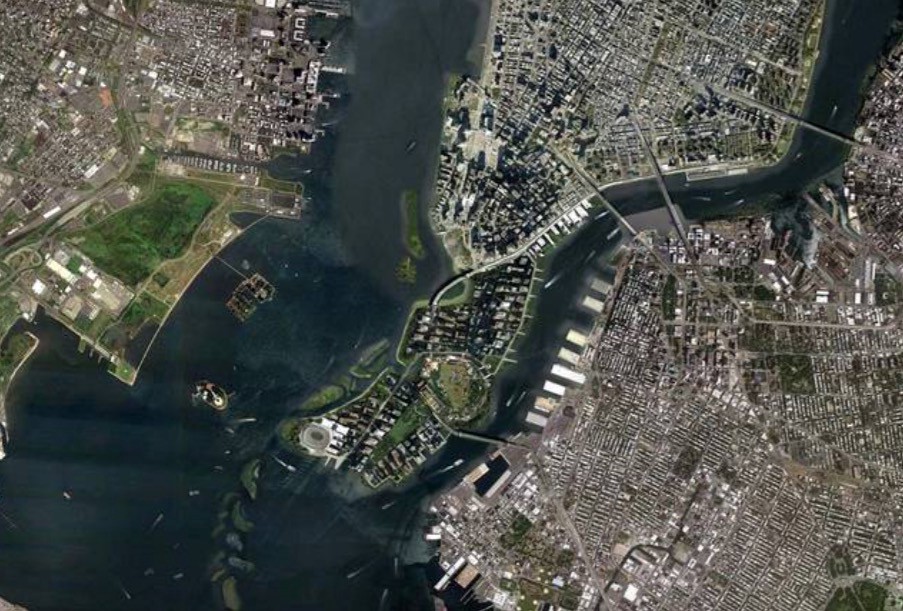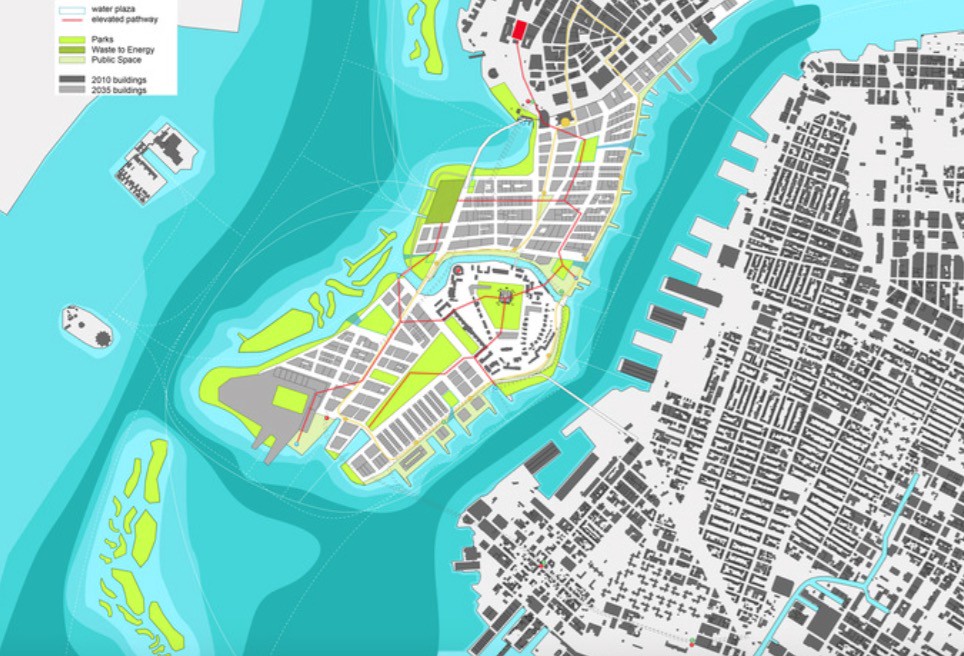Let's Build a New Borough

In late 2014, reports surfaced of a floating park that would be constructed in the Hudson River. The stilted park, financed by Barry Diller, would feature paths, open spaces, and a concert venue, and would cost roughly a hundred and thirty million dollars to complete. Roughly the size of half a city block jutting out into one of the region’s oldest shipping lanes, engineers would drill three hundred columns into the floor of the Hudson River so New Yorkers could enjoy concerts in an ocean breeze venue. If it is possible, financially and technologically, to build a three-acre park in the river west of New York City, then why isn’t it possible to construct an artificial island at a higher elevation than downtown Manhattan that would serve as New York City’s sixth borough? Many of the city’s problems — real estate prices, developers purchasing blocks at a time, the astronomical cost of parking a car, or even a bicycle, even shoreline erosion — are problems of space. So why not just build more space?
The stilted park, along with the conspicuous lack of a backyard outside my apartment window, intrigued me enough to begin investigating.
The majority of experts — professors, land dredging experts, energy conservationists, maybe even ship captains — were prompt to suggest reasons why such a concept is preposterous. But practicality is boring. Common sense is overrated. Pragmatism is impotent. Always approaching problems in a reasonable manner suggests that we should have never landed on the moon. Or relieved chickens of their wings to invent the most delicious appetizer ever. As I talked to more people, the question became not should the city build an artificial borough right now. Rather, setting aside present financial, environmental, and legal impediments: Is the engineering feat simply possible?
The roughly ninety-two acres that make up Battery Park City were built using a combination of dredged materials from New York Harbor, as well as excavation debris from city construction projects. There’s been thought of filling in the Harlem River to create four hundred to eight hundred acres of land. Dubai has been building artificial islands for years, and land reclamation is a common initiative in Japan’s Tokyo Bay. China built a runway in the middle of the South China Sea. As a city, we embrace solutions to the daily commute, such as a plan to connect Brooklyn and Manhattan via gondola. As a society, we are not short on global initiatives. Our civilization is hoping to begin a colony on Mars by 2025. More locally and, perhaps less desirable, Russia has proposed a superhighway that would allow motorists to drive all the way from London to New York. Reinvention and creative evolution are in our nature.
So why not a massive public project, an architectural feat the city has never seen, an unconventional and extraordinary construction project that would remake the entire geography of lower Manhattan for decades — our generation’s Brooklyn Bridge? Manhattan is a giant Frankenstein’s monster of an island, Gotham with a plastic surgery addiction. Throughout history, folks have concocted plans to enlarge it, connect it, dig beneath it, drill into it, protect it from rivers, make it more habitable to inhabitants who, quite honestly, want to enjoy the benefits of forward-thinking construction without putting up with the noise outside their bedroom windows.
“It’s a great idea,” Ted Steinberg, a professor at Case Western Reserve University and author of Gotham Unbound: The Ecological History of Greater New York, told me. “Unfortunately, you’re about one-hundred years too late.”

Before leaping into the mad science behind creating islands out of nothing, any real estate agent will harp on the importance of finding the perfect neighborhood. Taking a look at a map of New York City, there’s not a lot of extra space for island dredging, but a prime location for a hypothetical sixth borough would be in New York Harbor’s Upper Bay. There are several possible locations, between Liberty and Governors Island, or toward the New York side of the harbor adjacent to Brooklyn’s Red Hook area. There is also precedent to consider.

LoLo, or Lower Lower Manhattan, was a 2011 proposal to build a land bridge out of dredged material, connecting lower Manhattan to Governors Island, and then to Brooklyn. It would encompass more than ninety acres including schools, housing, and open space. Additionally, it would allow extension of subway lines and bridges to connect Red Hook more directly to Manhattan. According to a 2011 New York Times article, “The landfill would come from the Army Corps of Engineers, which is dredging New York Harbor to maintain and deepen shipping channels. Over the next 55 years, the corps is expected to dredge 180 million cubic yards of material, with the vast majority winding up in landfills and abandoned mines across the country.”
Scott Hayner was one of several research students who worked on the project as part of Columbia University’s Center for Urban Real Estate. While it was only a university project, with no actual sand being moved, he said there was considerable pushback at the time. “The crux of the argument against it was people who heard about the proposal without seeing the complete reasoning. They said, ‘It doesn’t make sense; it’s not financially viable; you’re ruining lower Manhattan.’ What they didn’t realize was that a hundred years ago, Manhattan was smaller than what it currently is. Battery Park and other areas have been created from dredged or landfill material.”
The project was not simply about thinking of ways to build new real estate to house further Walgreen’s and Dunkin’ Donuts. Hayner said LoLo took a complete look at what made a borough a home — accounting for transportation, infrastructure, residential housing, even shoreline concerns for rising tides.
“[The project] wasn’t just about dredging additional land. Some of these other aspects were why this made a lot of sense,” he explained. “Connecting lower Manhattan by train to Governors Island, then a natural progression into Red Hook. It’s pretty widely agreed that Red Hook lacks public transportation compared to the rest of the city. It’s much cheaper to build a subway doing the techniques we looked at where you use precast concrete tubes, pull them down to the bottom of the water, and then fill in dredged material on top of the new subway tunnel. The method is enormously less expensive than building a tunnel under the river.”

Professor Steinberg is a historian of the metropolitan area’s ecological history and admittedly, neither a fan of LoLo nor Frankenborough. “When you’re talking about expanding New York City, these ideas go back to the nineteenth century,” Steinberg said. “The modeling that has been done with respect to sea levels in New York’s surrounding waters suggests there is a twenty-five to seventy-five percent chance that by the middle of the Twenty-First Century the water will rise eleven to twenty-one inches. So within thirty-five years that will aggravate the problems of coastal flooding. And I’d be concerned about building anything in the riskiest zone.”

While no one has ever attempted a Frankenborough in the middle of New York Harbor, Steinberg has a point. In addition to the land reclamation of Battery Park City and Liberty Island, New Yorkers have been playing mad scientist with Mother Nature for centuries.
- When the Dutch arrived in the sixteen hundreds, the encountered a strip of land, known by the Lenape people as Mannahatta, which was simply a barrier that protected the mainland. The Dutch were the first to begin land reclamation.
- Marble Hill has undergone several facelifts. “In the eighteen hundreds the City relocated the [Harlem] river, essentially separating Marble Hill from Manhattan and made it a part of the Bronx,” Leith Ter Meulen, president of Landair, a planning and development consultant, said. “The people who lived in Manhattan were upset they were now a part of the Bronx.”
- In 1916, urban planner Kennard Thomson proposed filling in the East River to connect Brooklyn and Manhattan, a feat that would have rerouted the entire river west.
- A similar plan in 1924, but for entirely different reasons, sought to fill in the East River to solve traffic congestion. Instead of pesky water that might drown commuters, engineers were planning to build additional roads and parking spaces that might kill commuters with emissions, or front bumpers.
- A decade later, in 1934, Norman Sper, an engineer, had an entirely different idea — fill in the Hudson River and connect Manhattan with New Jersey.
- And as recently as last September, a plan to revitalize the northern boroughs proposed filling in the Harlem River.
Apparently, the thing New Yorkers hate most about New York is not the lack of space. It’s the rivers.

Before we can start arguing about an appropriate name for the sixth borough, or printing up cool tee-shirts — Bushwick, Hell’s Kitchen, BKLYN, FRNKN(boro) — first we must establish a method to create land mass. There are some alternatives to simply dredging the ocean floor. We could build a giant, sustainable bioreactor landfill, fill it with solid waste from local landfills, then build a neighborhood on top of it — a possibility environmentalists might applaud. We could construct a circular cofferdam, pump out the water, but then we would still face the issue of where to find enough material to fill in the hole. That leaves dredging.

Taking into account political, bureaucratic and environmental factors, the engineering behind such an endeavor is the easiest aspect of constructing a land mass in New York’s waterways. North Carolina State University Professor Billy Edge, an environmental engineer, says that dredging the ocean bottom is the most efficient process to obtain fill material. In layman’s terms, “It’s nothing more than a vacuum cleaner that uses water instead of air. A barge with a large pump connects to a pipe that extends to the bottom. At the end of the pipe is a rotating cutter. It rotates around, disturbs the sediment, which is then pulled up through the pipe and distributed.”
Land reclamation is not new to lower Manhattan — along with Battery Park City, parts of Liberty Island were built using dredged material, according to Bill Hanson, an engineer with Great Lakes Dredge & Dock Corporation, which handled the Liberty Island project. “Ideally, the cheapest land reclamation would be to go within the [New York Harbor] and just pump it in,” Hanson said. “That’s the easiest solution from an engineering perspective, but you would never get the permits. So you would start looking offshore, some place that offers a mutual benefit from dredging a shipping channel as well as using the material for reclamation.”
Once those minor issues are in place — barge, workforce, sign off from the various municipalities and Army Corps of Engineers — essentially, to borrow a summer analogy, the work resembles the principles of sand castle construction. “You build a dike, or a large fence, around the dredged material to keep it in place,” Edge said. “It might go down twenty feet, thirty feet. The dike has to extend down into the ocean floor — think a giant Popsicle stick wall, in which the sticks are made out of concrete. Once in place, it’s filled with dredged sand until it reaches the desired elevation.”

So what’s a small island downtown with excellent views of Manhattan going for these days? From a dredging perspective, Edge put the number at about ten to fifteen dollars per cubic yard of dredged material as a general rule. For a project this size, Hanson suggested a starting point would be twenty million cubic yards of material, or roughly two hundred to three hundred million dollars to start.

“There are so many variables that make it difficult to price, but assuming we’re building it up to a height of ten feet, that’s a fair guess,” he said. “It would also depend on the quality of material. The good thing about New York Harbor is that it’s mostly rock, which is a good foundation when you’re pumping sand on top.”
While expensive to build, similar to LoLo, Hayner believes the benefits of land dredging make it feasible from a financial standpoint. “Affordable housing, no matter who you talk to, is one of the things the city is lacking. You can provide developers the opportunity to build affordable housing, at a price that makes sense because you’re able to dictate the amount of land and development rights to be used for office and residential use.”
Great Lakes has worked in the New York area since the early nineteen hundreds, and is currently maintenance-dredging the harbor of material that cannot be placed into the ocean due to environmental restrictions. The material has to be loaded on barges and shipped to other states, where it is treated and used to fill in abandoned mines, Hanson said. “It’s a huge expense to transport that material out of state. If you had a site where it could be put to use in New York Harbor, it would be both a business opportunity and a mutual benefit,” Hanson explained. “The Port Authority of New York & New Jersey is very active in the long-term management of the channels and if the [Frankenborough] project existed they might grab hold of it and do that. It’s a huge long-term economic benefit.”
Perhaps there’s a mutual benefit to be found with the environmentalists as well. More than a giant plot of dirt, it can be a thoughtful neighborhood built at a higher elevation than downtown Manhattan — green space planned with residential housing, retail development powered by solar and wind energy. “Floating pontoons with solar panels all the way around the island,” Logan Winston, a Brooklyn-based consultant who specializes in renewable energy, offered. “Another way to squeeze out energy is to put turbines in the river and pull energy from those currents. You can integrate solar into buildings. There are islands in Maine and Scotland that are running off wind turbines.”

It’s hard not to side with the naysayers.
“Don’t use the word ‘impossible,’” Hanson cautioned. “Use the word ‘difficult.’ There are a lot of variables, but nothing is impossible.”
“I don’t believe it’s going to happen in our lifetime,” Hayner said. “The current state of mind of people today is so anti-change, the catalyst of pushing something like this forward would have to be so major that there would be no choice. Compare it even to our subway system — people are so unwilling to just change their commute to facilitate the proper maintenance and upgrades, something like this is unlikely to happen.”
Beyond the financial cost, or a potential lack of public support, there are countless permits and politics to navigate. Kevin Thurman, a New York City-based attorney, said a public benefit corporation might serve as the appropriate model. “Dredging or depositing landfill in the area surrounding New York City would require the navigation of various local, state and federal review and approval processes. But in a broader sense, new land in relation to coastal boundaries would need to reflect some kind of reconciliation of public and private interests,” Thurman said. “Historically, most major public works have been contingent upon ingenuity and timing, not to mention personality and exceptional determination on the part of one or more very influential individuals.”
The public approval process provides a wide opportunity for protest: Barry Diller’s floating park has run into legal hurdles; a local group filed a lawsuit, asking that the project undergo an environmental review. Any construction project, no matter the scope or location, is an inconvenience to the local animal populations, which environmental are efficient in pointing out. “One environmental issue we’ve come across in the harbor is winter Flounder,” Hanson explained. Flounder come inland to spawn during the winter months. “There are restrictions on our work because of that, which can drive up costs. We’re only allowed to work seven-eight months a year, which can double the amount of time.”

Lawyers, professors, urban planners and engineers all have one thing in common — before the first shovel hits dirt, they want one questioned answered first.
“The threshold question upon which others rest is: Why?” suggested Thurman. “If we accept that New York City is special, what does more land here help achieve? Housing? Economic development? Parkland? Renewable energy? Storm barrier protection? If any of these is the goal, aren’t there easier ways to achieve it? I keep returning to the same question: Why?”
Steinberg agreed that such a massive project requires a compelling impetus. “Another objection I have is a moral objection. If you came to me and had this idea for a sixth borough that was going to solve our homeless problem, I might think of ways to proceed. But this is creating millions of square feet of space to make developers money. It’s not solving the homeless problem, or any problems.”
Elliott Sclar, Professor of Urban Planning at Columbia University, believes such a substantial amount of money, technology and effort could be better used to leverage environmental changes rather than trying to fight them. “If we had the funds, then what would be so sacrosanct about saving lower Manhattan?” Sclar asked. “Why in the world do we need another island?”
It’s possible that our fixation on fighting Mother Nature centers around our history with the region. “There are a set of values as to why we would want to preserve it. It’s not for the physical value of the buildings. In a few generations, 9–11 won’t have any meaning, just as Civil War monuments lose meaning,” Sclar said. “It’s because people live here. We are gregarious animals. We are pushing up against the boundaries that Mother Nature has set for us. There’s something urban in this story.”
E.B. White famously wrote in 1949, in his essay “Here is New York,” that there are, in fact, three New Yorks — the New York of those born here, those who commute to work here, and those born elsewhere who come to be inspired and reinvented. White wrote, “It is this third city that accounts for New York’s high-strung disposition, its poetical deportment, its dedication to the arts, and its incomparable achievements.”
Living here, in spite of the traffic and tourists, the long lines for most anything worth watching or chewing on, is a privilege that morphs into identity. We’re proud of our neighborhoods. We brag about our commutes. That we live in a flood zone beneath perilously tall buildings is simply another challenge to overcome, like sneaking from ledge to ledge during thunderstorms in order to not fork over five dollars for umbrellas. We descend into subterranean pits most mornings to board packed trains, which magically transport us to new neighborhoods and futures, the closest proximity to time travel. We are daily witnesses to new technologies, city blocks being reinvented, spouts of charisma and grit that define our urban culture. We have plots of park and corner bars that are ours, faithful routines, impossible anecdotes that bind us to the New York story. And more of us arrive each year.
To steal Walt Whitman, “That the powerful play goes on, and you will contribute a verse.” That’s an honorable answer to the question why: that New York will continue to be reinvented a century from now because we helped it evolve when it was our time to contribute.
Images created by Lucien Wilson, Muchan Park, Leigh D’Ambra, and Scott Hayner
